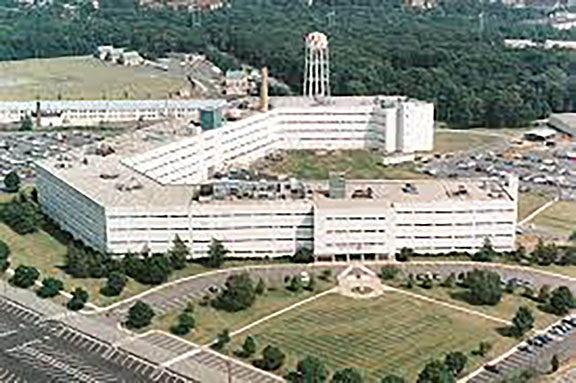
By Laura D.C. Kolnoski
FORT MONMOUTH – Robert Wood Johnson Barnabas Health (RWJBH), has requested and received square footage increases for its planned state-of-the-art Vogel Medical Campus on about 38 acres of the former Fort Monmouth in Tinton Falls. The Fort Monmouth Economic Revitalization Authority (FMERA) unanimously approved the changes at its monthly meeting Feb. 16.
The project will be constructed in phases. Plans originally called for an approximately 138,000-square-foot cancer center and ambulatory care pavilion with oncology services, imaging, radiation and an ambulatory surgery center; an approximately 568,901-square-foot acute care hospital with about 250 beds; a 206,768-square-foot clinical and support building; an approximately 137,000-square-foot medical office building; a 34,000-square-foot central utility plant; and an approximately 404,000-square-foot parking facility.
With the approved changes, the acute care hospital, still with approximately 250 beds, can be at least 500,000 square feet but can’t exceed 605,000 square feet. The clinical and support facility can be at least 190,000 square feet, not exceeding 326,000 square feet. The central utility plant remains at 34,000 square feet. The parking facility can now be up to 940,000 square feet. Fort Monmouth’s master reuse plan permits the increases.
The project’s second phase includes a combination of open space, public areas, trails, gazebos and landscaped areas, which remain unchanged from the original plan.
“This provides a range of square footage for RWJ to work with and gives them some flexibility,” said FMERA chairman Robert Lucky, adding FMERA’s real estate subcommittee “had no problem with that.”
The health care firm entered into an agreement to purchase the site from FMERA in 2017 for $8 million, after a Cold War-era facility on the site was demolished. Ground has yet to be broken for the campus, located at Corregidor Road and Pearl Harbor Avenue where the five-story, hexagonal Albert J. Myer Center once stood. The project is still winding its way through the approval process, which involves state, county and municipal entities.
“There are many layers of reviews with such a huge project with so many technical issues,” said FMERA executive director Bruce Steadman. “Internal stakeholders have many inputs and desires to make a facility that will be useable and provide benefits for many years. Unanticipated things happen and the plans get tweaked from time to time to make sure they have all they need.”
Steadman said the pandemic has also impacted the project’s progress, as it has with other redevelopment efforts on the former U.S. Army base. Environmental testing and remediation are also in the mix.
“The New Jersey Department of Environmental Protection is satisfied with the plan; all is going well,” Steadman continued. “FMERA has a top-notch relationship with the outstanding professionals at RWJBH. Technical review meetings with the borough have gone well. These delays are only natural given the scope of the project.”
“As we plan and design the Vogel Medical Campus, we continue to refine our requirements to meet the health care needs of the community,” said Elizabeth Brennan, regional director of marketing and public relations for Monmouth Medical Center. “The parameters of the proposed development remain within those of the governing land use regulations. The overall footprint, height and look of the project remain unchanged. Over the next six months, we will continue the planning and designing process while simultaneously working to secure necessary regulatory approvals.”
The Myer Center was a famed research and development lab known for technological innovations including the invention of night vision goggles. It was first offered for sale in 2014, but early attempts by FMERA to sell the 673,000-square-foot structure and its 43,230-square-foot Night Vision Lab were unsuccessful. Officials said prospective buyers liked its location near the recently expanded Garden State Parkway Exit 105, but its age and condition, combined with the difficulty and cost of retrofitting and modernizing the 70-year-old facility, proved prohibitive. The New Jersey Economic Development Authority, which oversees FMERA, decided to pay for its demolition to make the site more appealing to prospective buyers.
Located next to the CommVault building, one of the first successful fort redevelopments, the site is zoned for commercial, not residential development. The campus is named for the Vogel family of Colts Neck, who have long ties to Long Branch and Monmouth Medical Center, and have donated millions to RWJBH.
Created by the merger of Robert Wood Johnson Health System and Barnabas Health in 2016, RWJBH includes Monmouth Medical Center in Long Branch.
Infrastructure Upgrades
In addition to the higher profile projects underway at Fort Monmouth, crews have been working for the past few years to upgrade and replace old water lines and electrical systems to meet the needs of the fort’s current and future residents and businesses.
Kristy Dantes, FMERA director of facilities and infrastructure, reported Feb. 16 that the installation of a New Jersey American Water Company water main along Route 537 through the fort is complete. Afterward, FMERA’s voting members unanimously approved an agreement between FMERA and Jersey Central Power & Light for installation of electrical distribution facilities on the main post within the borders of Eatontown and Oceanport.
According to FMERA staff documents, “the existing system is aged and trending toward obsolescence. FMERA must replace this infrastructure with a new substation and ancillary electrical equipment… in anticipation of the possible future development on the Main Post.” The work has the approval of the New Jersey Board of Public Utilities.
“We believe 17 megawatts will fill the need, but we went up to 22 megawatts in case we missed something,” Steadman said. “This is the first stage. The second stage is for design and replacement of the entire distribution system including poles, wires and other components.” The state is funding the $12.5 million cost.
The article originally appeared in the February 24 – March 2, 2022 print edition of The Two River Times.














